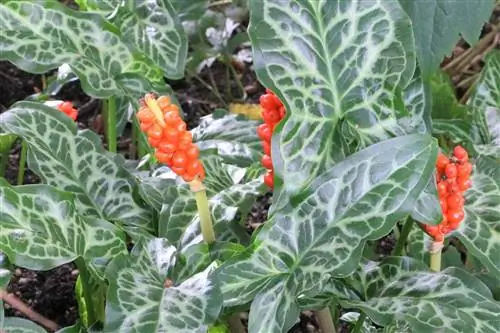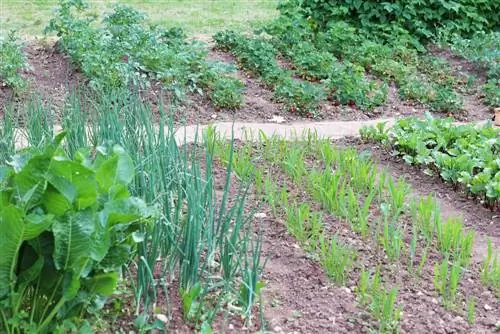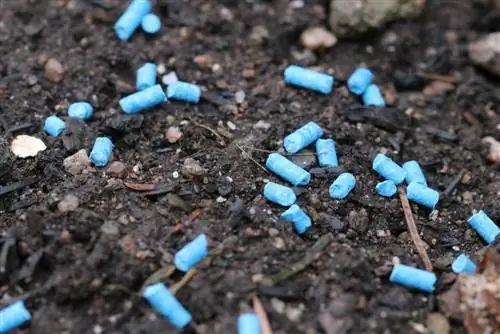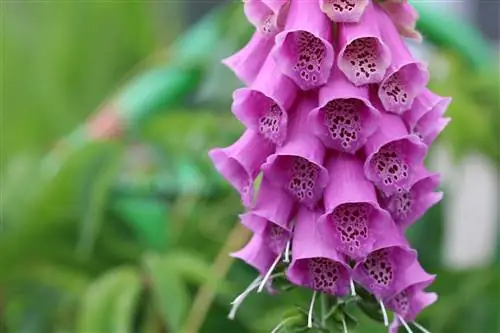- Author admin [email protected].
- Public 2023-12-17 03:39.
- Last modified 2025-01-24 12:45.
Eye-catching, decorative and easy to care for - anyone who cultivates the spotted arum in their home garden is guaranteed to attract a lot of attention to their garden. The plant, which is also popularly known as stomach root, donkey's ear or priest's spinach, impresses with its long-stemmed, arrow-shaped leaves and special fruit clusters. If you choose the right location for the plant, you no longer need to worry much about further care.
Location and soil
So that the spotted arum feels comfortable and can develop optimally, the future location of the plant should be chosen carefully. The plant grows best in partially shaded areas within the green area; Both excess sun and too much shade can have a damaging effect on the plant. Ideally, the spotted arum is cultivated on the edge of the wood and under deciduous plants. This way they get enough shade in the summer and enough light during the budding period. Overall, a somewhat cool location has proven to be beneficial.
Tip:
The deeper the shadow, the sparser the flower appears and the fewer berries will subsequently form. It has proven useful to cultivate the spotted arum in association with other plants.
The community is particularly suitable for other spring-flowering plants, such as lungwort or wild garlic. In addition to a suitable location, the right substrate is particularly important for the successful cultivation of the spotted arum. The soil that should be used ideally has the following properties:
- rich in nutrients
- quite loose
- something fresh
- permeable
- a little sour
You should never choose the substrate too dry, but also not too moist. There should be no waterlogging that could damage the plant. Deep loamy and clay soils as well as moist leafy soils are particularly suitable.
Watering and fertilizing
Caring for the spotted arum also includes balanced watering behavior. Regular watering is particularly important in the early stages of the growing season because the soil must not dry out during this time. Later, in midsummer, additional irrigation is usually no longer necessary. From summer to autumn, when the plant is in the dormant period, the arum can be kept almost dry. Optimal fertilization has also been proven to ensure good care of the arum. For this purpose, it has proven useful to incorporate compost and organic fertilizer into the soil; Spring is best suited for this measure.
Planting and Propagating
Planting an arum stick works without any particular problems if you pay attention to the right location. This should not be too close to the edge of the tree because the plants require a certain amount of space. You should also carefully consider the future location, as moving it later will damage the plant. You should allow for a distance of 40 to 50cm between the individual specimens. It is best to plant the plants in small tuffs of 3 to 10 specimens. When inserting the individual plants, make sure that the tip of the tuber points upwards. Basically you should plant twice as deep as the tuber is thick. Then press the soil carefully and ensure good watering.
Tip:
The tubers or plants should only be touched with gloves, as all parts of the plant are poisonous!
The propagation of the spotted arum is just as easy. The reproduction works using the following methods:
- Self-seeding
- targeted sowing
- Dividing onions
The spotted arum usually reproduces in the garden without any external intervention; However, the strong tendency to multiply can also have a disruptive effect on the general garden landscape, so that many hobby gardeners feel forced to stop the growth. Then the red fruit stalks are removed before they ripen. The spotted arum can also be reproduced through targeted sowing. The seeds are cold germinators that require sowing temperatures between 10 and 15 °C. If the temperatures are too high, germination will be prevented. In order to successfully cultivate the seeds, it is best to place the containers with the seeds in a protected place outdoors; Germination then occurs either in spring or late autumn. The seedling plants are stored frost-free and sunny in the first winter, with temperatures of at least 5 °C. In the second spring after sowing, targeted planting can then take place.
Cutting
As a rule, the spotted arum does not need to be cut. After flowering, the leaves die down and can be removed with a knife or pulled out of the ground once they have withered completely. However, targeted pruning has proven useful if the plant is to be prevented from self-seeding. Then you cut off the fruit stalk in good time - in any case before the berries are bright red and ripe. If you leave the thick stem standing, it will wither and can easily be pulled out later.
Wintering
The spotted arum is well hardy; The plant is frost hardy down to -20 °C. For this reason, it is usually not necessary to provide the plants with additional protection so that they can get through the winter well. Even without help, the spotted arum sprouts again next year - sometimes even in February.
Diseases and pests
Since all parts of the arum are poisonous, there are no natural enemies worth mentioning. However, care errors can lead to the development of various diseases. For example, if the plant receives too much water during the dormant phase, the tuber can quickly rot.
Poisonousness of the plant
The spotted arum is very poisonous in all parts of the plant; Small children, who like to snack on the berries, are particularly at risk. However, 60% of all cases have no symptoms after consumption; The rest experience inflammation of the mucous membranes or gastrointestinal problems. Serious poisoning, however, occurs primarily in grazing livestock. It should also be noted that the fresh plant and its juice have a stronger effect than the corresponding dried plant parts. The ingredients of the plant are still largely unknown; However, the main active ingredient is said to be aroin, which is found in particularly high concentrations in the fresh tuber.
Name origin
The name arum refers to the flower spadix of the plant and refers to the Old Testament of the Bible. Exodus tells of how Aaron threw his staff before Pharaoh, and the stick then turned into a snake. The genus name maculatum is borrowed from the Latin language and means spotted; this refers to the leaves.
Conclusion of the editors
The spotted arum is one of the particularly eye-catching and therefore decorative plants in the local green area. The plant is easy to cultivate and even beginners can successfully plant and care for it. However, you have to be aware of the strong tendency to self-sow and, if necessary, take measures in good time so that the spotted arum does not become a problem in the garden. If you pay attention to the toxicity of the plant, you will certainly enjoy the plant for a long time.
What you should know about the Araceae in brief
Special features
- The arum grows up to 50 cm high and blooms from April to May.
- This forms a large bag-shaped leaf containing a mostly brown bulb.
- This bulb smells like carrion and attracts flies and mosquitoes that pollinate the flowers.
- From August onwards, small round fruits form that are initially green and later turn red.
Tip:
The berries in particular are dangerous for children and animals because they taste sweet, but all other parts of the plant are also poisonous.
They contain oxalate and other toxic substances that cause redness and blistering on the skin when touched. When eating the berries or other parts of the plant, nausea, vomiting and diarrhea usually occur within half an hour. The toxic substances can also cause inflammation of the oral mucosa and swelling of the lips, which is associated with a burning sensation in the tongue and throat. Consuming a large amount of arum leaves can be fatal for livestock.
Species
- The single leaf (Spathiphyllum) fits well on the windowsill because of its small size and has a white bract in which the flower spadix sits, which lasts on the plant for a very long time. It is one of the plants that can survive with little light, but the location must not be completely dark. In direct sunlight, the leaves of the single leaf can quickly become pale and develop brown edges.
- In its original home, which is in the jungles of Central and South America, the window leaf climbs up trees with its aerial roots to reach the light. With good care, it grows almost as quickly as a houseplant, so after a few years it can be too big for indoor use and needs to be cut back. When looking for another location, you should keep in mind that a window leaf needs a temperature of at least 20° C all year round.
- The tree friend (Philodendron scandens), like the window leaf, is a climbing plant and therefore needs a climbing aid. It likes it a little cooler, but the temperature should always be above 15°C. The location for this plant should be bright, but the tree lover does not like direct sunlight. Its leaves are not cut, as is the case with the window leaf.
- The Dieffenbachia is a very popular houseplant and usually does not grow taller than two meters, making it well suited for normal room heights. It has elongated or oval green leaves with white spots and therefore looks very decorative. However, Dieffenbachia is not particularly suitable for households with small children or animals because it contains calcium oxalate crystals, which are toxic to humans and animals.






